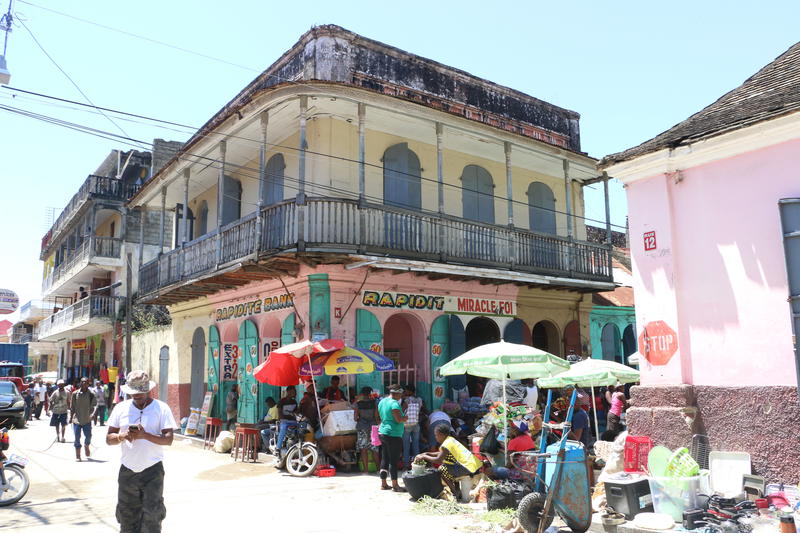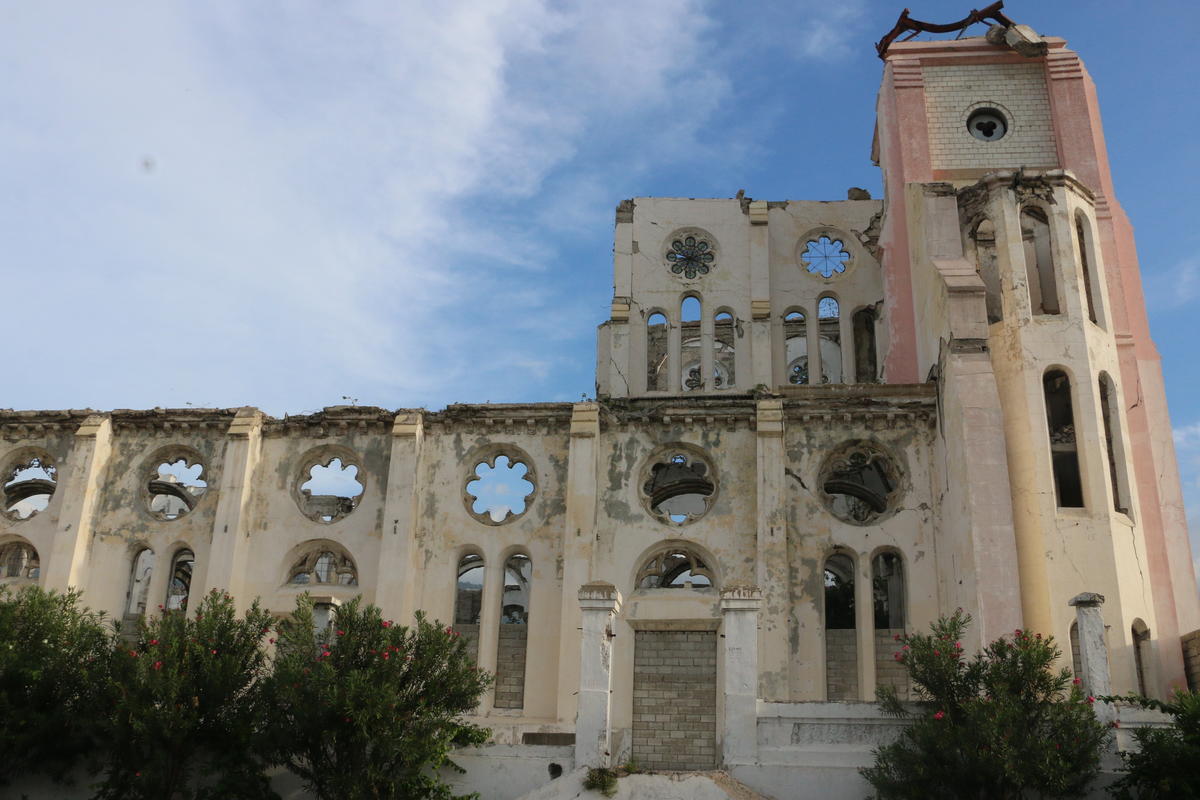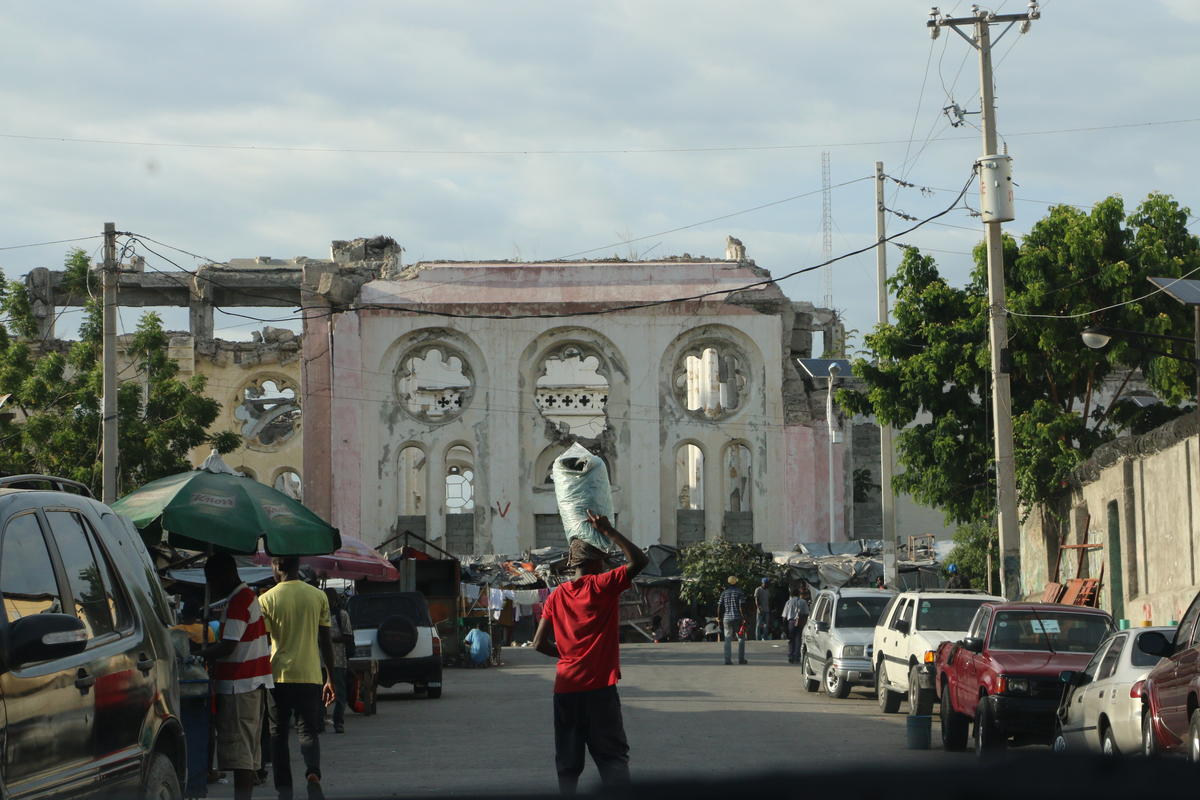PART III: More Than A Feeling
Gigi Dupuy holds a vodou flag in the Pacot neighborhood of Port-au-Prince, Haiti.
Gigi Dupuy was born in Haiti, but her family moved to the states when she was a kid. Now her kids are all
grown up, and they live in New Orleans. They urged her to move here, and said she would feel at home. So, she did.
“Leyla, my daughter called me, and she said, 'Mom, you need to move to New Orleans. It's so much like Haiti, you're gonna love it. There's corruption, there's potholes. It's just an incredible place,'" says Gigi. "Of course that's not what I love about Haiti but…”
With a last name like Dupuy, a lot of people assume Gigi is from New Orleans. “But it took me a while to realize that,” she says. “Until I went to yoga class. The woman registering participants said to me, ‘What's your first name?’ And I said, 'well, I'm sure there's only one Dupuy,’ because there never was more than one Dupuy! And she said, ‘no, actually I have six.’ And I was like what?!”
“You go into the phone book in New Orleans, and it’s like you’re looking in the phone book in Haiti,” says Vladimir Laborde, the Haitian businessman who went to High School in New Orleans, and then moved back to Haiti. “You find Labordes, you find Toussaints, you know. All those people have my family’s last name.
When Gigi goes back to Haiti to visit her cousins, she talks about New Orleans. “I say it's very similar. The most similar.”
No matter what’s happened to this relationship over time, New Orleans and Haiti still have so much in common. And it’s more than names, and colonial buildings. When I was there, I saw snoballs, the New Orleans version of shaved ice, I ordered to-go drinks, I weaved around huge potholes, I heard a brass band tuning up for a jazz funeral, I saw people cooking with mirliton, I saw a vodou ceremony, I read the names of businesses spelled out on hand painted signs, I waded through flooded streets up to my knees after a fast and hard rain. I could go on. We’re a lot alike. The good, the bad, and the disastrous, says Valdimir Laborde.
“Not only do we have historical and cultural ties, but we have a traumatic experience that almost wiped us out,” he says.
New Orleans has Hurricane Katrina, which ravaged the city in 2005, and Haiti has its earthquake that hit in 2010. The quake devastated most of the country, leveling cities and destroying major landmarks, that, as of 2017, are still piles of rubble. The degree of blight reminded me of some of the largest buildings in New Orleans that have been left virtually untouched since Katrina. Like Charity Hospital in the center of downtown. And, like in New Orleans, the aftermath of disaster isn’t just seen. It’s heard.
Jean-Elie Gilles, the tour guide in Jacmel, gave us a long tour of his house that day, because he has a large collection of Haitian art and antique furniture he wanted to show off. He started talking to us about a coffee table in his living room. There must have been something about that table, because before we knew it, Jean-Elie was back in 2010.
“I was living on the 6th floor and the house went down. I was inside. I was all the way living upstairs, and then I fell. And then I look up outside and I saw the house that was beside me, that was taller, didn’t exist anymore. That house became a pile of crap. And then pretty soon, the house just went down like that. It was like a pile of cards, you know? Like nothing,” he says.
He went on, with no idea how long ago he had stopped at the top of his staircase, looking beyond all of us, past the house we were all standing in, at the house he lost. “Now I am telling you, I am swearing that I could hear the sound of the earth crying. It’s worse than anything that you have ever heard. It’s like the sound of 10,000 women screaming from the womb. Oh it’s scary. I heard it, and I was not the only one! Very painful, painful. OK let’s go.” And then, just like that, he turned on his heels and flew down the stairs.
This kind of time travel, this relived trauma, still happens in New Orleans, too. “New Orleans went through Katrina, so they know a lot about disaster,” Vlad recalls.
And they know what it’s like to see a city full of holes. When our driver Andre gave us a tour of Port-au-Prince, most of what he stopped to show us were things that used to be there. Things that aren’t there anymore. “And that's why after the quake we felt like we were lost. Because all the landmarks that we could use to indicate a place...like we say, 'near the Cathedral,' 'near the national palace,' most of them were gone. Same as after Katrina, I guess.”
After the earthquake slammed Haiti in 2010, and again after Hurricane Matthew in 2014, people around the world asked themselves what their obligations are to this country. A country that, throughout history, has been cast aside, and treated as "other." Well, Vlad Laborde says, New Orleans knows what that’s like, too.
“New Orleans, Louisiana, often times feels apart from the rest of the United States. Haiti often times feels itself apart from the rest of the Caribbean,” says Laborde.
After Katrina, people threw around the idea of not rebuilding the city, period. Like New Orleans was an expendable part of the United States. Or not part of it at all. The same way Haiti has been punished for its blackness, New Orleans was shunned, many say, for that same reason. Still, thousands of people did rush in to try to help. Haiti and New Orleans have both been on the receiving end of countless recovery projects, and NGO missions. And both places have felt exploited, seeing too many of these fail, over and over again. This shared experience and the mutual understanding it creates might put Haiti and New Orleans in a position to work together.
There’s a fear in Haiti that things are disappearing. Literally. Much of Haiti’s built environment is deteriorating. Whether it’s an earthquake that swiftly wipes huge landmarks off the map, or the slow crumbling of a 300-year-old shotgun house. Because New Orleans shares this distinct architecture, it knows how to restore — and preserve — Haiti’s historic buildings. John Williams runs Williams Architects in New Orleans. He’s done over 500 projects in the French Quarter and has also done a lot work in the Lower 9th Ward since Katrina.
“I didn't ever intend to go to Haiti,” he said. Nor did he want to. But after the earthquake, Vlad Laborde came a knocking.
“Well he brought me two bottles of Barbancourt,” he said. (Barbancourt is Haitian rum.) “So it was over then, you know? And I said OK.”
Since then, John’s been to Haiti more than 10 times, visiting cities devastated by earthquakes and hurricanes.
“I know little teeny hardware details and woodwork details that I saw in Cap Haitian that are exactly copied in the French Quarter,” he says. "Which means, he knows how to repair those details."
This is crucial, says Pierre Chauvin. He’s the former minister of tourism in Haiti, and says architecture in New Orleans is a huge attraction for tourists. Those walking tours of the Garden District, they’re all about ‘oohing and aahhing’ at old buildings. An artist named Paul Baruk knows this. “This is what I want Jacmel to look like. Nouvelle Orleans.”
Paul runs one of the many Carnival themed art galleries in Jacmel. When I told Paul where I was visiting from, that’s when she said she wished Jacmel looked like New Orleans. Or, even more like it.
“Because New Orleans looks like Jacmel, but Jacmel is not well taken care of. New Orleans is well taken care of, you see. And that would bring tourism. That would bring a new life for the people here. And it’s really what we need. Why don’t you send us some tourism?” She laughed too, but she was serious. Like she was egging us on to share the wealth. Which is an interesting thought. Just because New Orleans can do this stuff, does that mean it should?
Dennis Kelly, the American businessman who works part-time in Haiti. Says there’s no way New Orleans can be responsible for Haiti or Haiti responsible for New Orleans, “but what you can do is look at what's coming down the road and say what opportunities are there that I want to take advantage? So I would say that there are many opportunities for the city of New Orleans and the city of Jacmel, and others, to mutually benefit one another.”
Vladimir Laborde is all about the mutual benefit, and says an obvious opportunity here, is Mardi Gras. “Imagine the Miami Herald, the Times Picayune, and The New York Times: ‘New Orleans and Jacmel, Haiti, Share Carnival 2018.’”
He sees Mardi Gras as an overlapping tradition that could raise the big bucks to revitalize cities like Jacmel. And that these revenue streams will make communities more livable for Haitians, and more hospitable for tourists. But these are tricky words in New Orleans. There’s endless debate surrounding who’s actually benefitting from preservation and tourism efforts. There’s skepticism towards these projects; are they actually improving the quality of life for the New Orleanian, or the quality of experience for the visitor?
These are some of the questions Haiti has to reckon with as it grows its tourism industry and preservation program. And both those things are important, not only for the economic boost, but that more existential fear of disappearing.
Pierre Chauvin, the former minister of tourism, will never forget a conversation he once had with a European colleague. “He came to visit Haiti and after one week, we ask him how do you find the country? And he said ‘you know, I have come to realize that in Haiti, you are full of diamonds. The whole country is full of diamonds. But you know, diamonds are stones. They have to be polished. Yet in Haiti, you don't polish them at all.’ And he was talking about these old houses, and you know our nature, and everything else that we have...And certain things are really crumbling. And you cannot re-create them.”
Haiti’s former prime minister Michele Pierre Louis says it’s not just about tourism dollars, or physical structures. It’s about Haiti reclaiming its image. “It’s extremely important that little students, little pupils know that the country is not deductible to violence and misery and poverty. Because we don’t have just drug dealers and bad politicians! We have Haitians that are great, that are artists, that are creative, that live with dignity.”
That’s the vision of Haiti that New Orleans chooses to see in itself. Which is fine, Michelle says, because it’s true. “The spirits of our two territories. There is a strong tie that has to do with what probably is the best of my country’s culture.”
It’s a reminder that so much of what we love about New Orleans, the culture we package to the outside world, and profit off of, a lot of that we got from Haiti. So what can New Orleans do in return? Michele says stop looking backwards 200 years when you think of Haiti, and make some new memories. “That would be great! That a new generation creates a momentum for, I wouldn't say reconciliation, but creating a connection back! That’s a good utopia."
When I got back to New Orleans, I took a walk in my own neighborhood in Midcity. It was a Sunday afternoon, and I saw a group of people standing around this now empty pedestal where a statue of Jefferson Davis once stood. The city removed this and three other confederate monuments in the spring of 2017. People took turns passing around a crappy PA system and climbing up onto the empty pedestal, sharing their visions of replacement statues. This is where I met Nic Aziz. “Looking forward I think we need to have monuments that reflect the true identity of the city. For me I think that identity is Haiti.”
Nic Aziz sits on top of the steps where a statue of Jefferson Davis once stood. He shares his vision of a new statue dedicated to Haiti.
Nic is 26. His mom was born in Haiti, and he’s a first generation New Orleanian. “Many people do not realize all the contributions that Haiti has to this city. I think a lot of the issues that we see, whether it's violence or you know economic opportunity or whatever some of that is rooted in identity issues. And I think if you show people who they are and like where they come from, that can have an impact on where they go.”
We’ve heard about folks not visiting Haiti. But Nic is one New Orleanian that did, back in 2011. He was 20. “As soon as I got there I felt something like you just felt...it was one of the most unique feelings of my life.”



